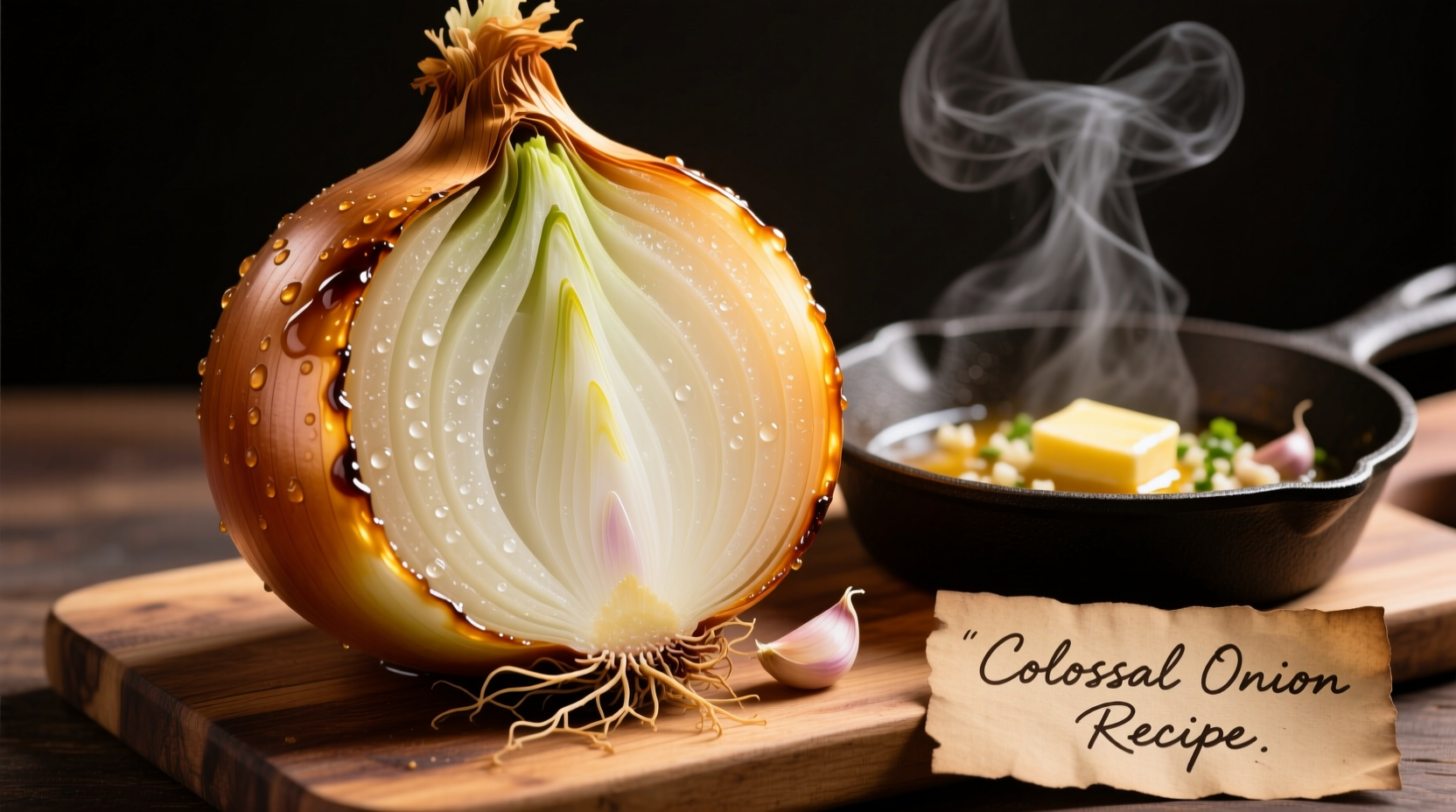Discover the perfect colossal onion recipe featuring the sweet, mild Colossal White Sweet Onion variety. This step-by-step guide delivers caramelized onion perfection with just 5 ingredients and 45 minutes of cooking time, yielding rich umami flavor without bitterness. Professional chefs prefer this variety for its high sugar content (8-10%) and low pyruvic acid levels, making it ideal for caramelizing, roasting, and raw applications.
What Exactly Is a Colossal Onion?
When searching for a colossal onion recipe, you're likely encountering the Colossal White Sweet Onion (sometimes called Colossal Bermuda), a specific variety developed for its impressive size and exceptional sweetness. Unlike standard yellow onions with 4-5% sugar content, colossal onions contain 8-10% natural sugars and significantly lower levels of pyruvic acid—the compound responsible for sharpness in regular onions.
| Onion Variety | Average Weight | Sugar Content | Best Culinary Uses |
|---|---|---|---|
| Colossal White Sweet | 1.5-2.5 lbs | 8-10% | Caramelizing, roasting, raw applications |
| Yellow Storage | 0.5-1 lb | 4-5% | Sautéing, soups, stews |
| Red Onion | 0.3-0.8 lb | 5-6% | Salads, pickling, garnishes |
| Shallot | 1-2 oz | 7-8% | Vinaigrettes, delicate sauces |
According to the National Onion Association, colossal onions originated from Bermuda onion stock改良 in the early 20th century, specifically bred for their large size and sweetness. Their low pungency makes them perfect for raw applications where regular onions would overwhelm other ingredients.
Why This Colossal Onion Recipe Works
The magic of this colossal sweet onion recipe lies in understanding onion chemistry. When cooking large onions like the colossal variety, the key is managing moisture content. At approximately 89% water, colossal onions require different handling than smaller varieties. Professional chefs at the Culinary Institute of America recommend a two-stage cooking process: first evaporating moisture, then developing flavor through the Maillard reaction.

Essential Equipment for Cooking Large Onions
Working with colossal onions (which can weigh over 2 pounds each) requires proper tools:
- Heavy-bottomed skillet (12-inch minimum) - distributes heat evenly for consistent caramelization
- Sharp chef's knife (8-10 inch) - crucial for safely handling large onions
- Microplane grater - for incorporating raw onion flavor without texture
- Mandoline slicer (optional but recommended) - ensures uniform 1/8-inch slices for even cooking
Perfect Caramelized Colossal Onion Recipe
This professional technique yields deeply flavorful onions without bitterness. The secret? Patience and proper heat management.
Ingredients for Colossal Onion Recipe
- 1 colossal white sweet onion (about 2 lbs), peeled and sliced 1/8-inch thick
- 2 tablespoons unsalted butter
- 1 tablespoon olive oil
- 1 teaspoon kosher salt
- 1/2 cup dry white wine or vegetable broth
- 1 teaspoon fresh thyme leaves
Step-by-Step Preparation Guide
- Prep the onion: Cut the colossal onion in half root-to-stem, then slice crosswise into 1/8-inch thick half-moons. Proper slicing ensures even cooking—thicker slices won't caramelize properly, while thinner ones burn.
- Initial moisture removal: Heat butter and olive oil in a 12-inch cast iron skillet over medium heat. Add onions and salt. Cook undisturbed for 10 minutes to begin evaporating moisture. Stir every 5 minutes for 20 minutes total.
- Flavor development: Reduce heat to medium-low. Continue cooking, stirring every 5-7 minutes, for 25-30 minutes until onions turn deep golden brown. This slow process develops complex flavors through controlled Maillard reaction.
- Liquid addition: When onions reach a light golden color, add wine or broth, scraping up any browned bits. Continue cooking until liquid evaporates and onions return to golden brown.
- Finishing: Remove from heat, stir in thyme, and season with additional salt if needed. The finished onions should have a jam-like consistency with deep umami flavor.
Pro Tips for Cooking with Colossal Onions
Mastering this colossal sweet onion recipe requires understanding these key techniques:
Temperature Control Is Critical
Unlike smaller onions, colossal varieties contain more water that must evaporate before caramelization can occur. Cooking over too-high heat causes exterior burning while interior remains raw. The University of California Cooperative Extension confirms that optimal caramelization occurs between 285-320°F (140-160°C)—below the smoke point of most fats but hot enough for the Maillard reaction.
When to Substitute Other Onions
While this colossal onion recipe shines with the namesake ingredient, substitutions may be necessary. Vidalia or Walla Walla onions make acceptable alternatives, but require 15-20% less cooking time due to their higher water content. Never substitute standard yellow onions in equal measure—they'll require additional sugar and longer cooking to achieve similar results.
Serving Suggestions for Caramelized Colossal Onions
These versatile caramelized onions elevate countless dishes:
- Burgers and sandwiches: Add 2-3 tablespoons to elevate any sandwich
- Pizza topping: Spread over white pizza with goat cheese and arugula
- Pasta enhancement: Toss with olive oil, Parmesan, and fresh pasta
- Appetizer base: Serve on crostini with blue cheese and walnuts
- Meat accompaniment: Pair with roasted pork or beef dishes
Storage and Shelf Life
Properly stored caramelized colossal onions maintain quality for:
- Refrigerator: Up to 5 days in airtight container
- Freezer: Up to 3 months in portion-sized containers
- Room temperature: Only 2 hours (per USDA Food Safety Guidelines)
When reheating, add a teaspoon of water or broth to restore moisture. Avoid microwaving, which creates uneven heating—gentle stovetop reheating preserves texture best.
Common Questions About Colossal Onion Recipes
Here are answers to frequently asked questions about preparing colossal onions:











 浙公网安备
33010002000092号
浙公网安备
33010002000092号 浙B2-20120091-4
浙B2-20120091-4